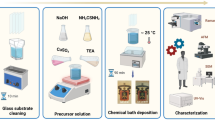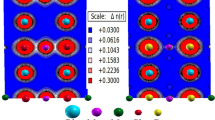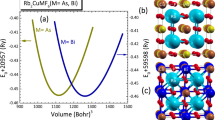Abstract
Niobium (Nb)- and antimony (Sb)-doped CdO thin films have been prepared on glass substrates by physical vapour deposition method in a vacuum environment. The films were characterized by the X-ray diffraction, optical absorption spectroscopy, and electrical measurements. The structure of the doped film samples preserved the CdO cubic structure. However, the band gap was shifted depending on the dopant type. Besides, it was observed that doping of Nb or Sb ions considerably improved the conduction parameters. However, the most important result was the significant enhancement of the carrier mobility of the host CdO:Nb film, in addition to the increasing in its conductivity and carrier concentration, which was attributed to the formation of multi-electron donors \({\text{Nb}}_{{{\text{Cd}}}}^{v - 2}\) of v > 2. The band gap of host CdO suffered shrinkage by ~ 7% with Nb doping and widening by ~ 3% with Sb doping that was explained by the simultaneous effects of Moss–Burstein and Urbach phenomena. The influence of annealing of the films in hydrogen atmosphere (hydrogenation) was investigated for a purpose of increasing the carrier concentration and oxygen vacancies. The great effect of the hydrogenation on the conduction parameters was studied and discussed. From the transparent conducting oxide point of view, Nb is sufficiently effective for CdO doping and even emulates other metallic dopants such as Sb, In, Sn, Sc, and Y.




Similar content being viewed by others
References
Z. Zhao, D.L. Morel, C.S. Ferekides, Electrical and optical properties of tin-doped CdO films deposited by atmospheric metalorganic chemical vapor deposition. Thin Solid Films 413, 203 (2002)
O. Gomez Daza, A. Arias-Carbajal Readigos, J. Campos, M.T.S. Nair, P.K. Nair, Formation of conductive CdO thin films on photoconductive CdS thin films for window layer applications in solar cells. Modern Phys. Lett. B 17, 609 (2001)
M.N. Amroun, K. Salim, A.H. Kacha, M. Khadraoui, Effect of TM (TM= Sn, Mn, Al) doping on the physical properties of ZnO thin films grown by spray pyrolysis technique: a comparative study. Int. J. Thin Films Sci. Tec. 9(1), 7 (2020). https://doi.org/10.18576/ijtfst
A.A. Dakhel, Influence of hydrogenation on the electrical and optical properties of CdO thin films. Semicond. Sci. Technol. 23, 055017 (2008)
D.M. Carballeda-Galicia, R. Castanedo-Perez, O. Jimenez-Sandoval, S. Jimenez-Sandoval, G. Torres-Delgado, C.I. Zuniga-Romero, High transmittance CdO thin films obtained by the sol–gel method. Thin Solid Films 371, 105–108 (2000)
K.L. Chopra, S. Ranjan Das, Thin Film Solar Cells (Plenum Press, New York, 1993)
Y.S. Choi, C.G. Lee, S.M. Cho, Transparent conducting ZnxCd1−xO thin films prepared by the sol-gel process. Thin Solid Films 289, 153 (1996)
R. Chandiramouli, B.G. Jeyaprakash, Review of CdO thin films. Solid State Sci. 16, 102 (2013)
E. Burstein, Anomalous optical absorption limit in InSb. Phys. Rev. 93, 632 (1954)
T.S. Moss, The interpretation of the properties of indium antimonide. Proc. Phys. Soc. Lond. B 67, 775 (1954)
A.J. Freeman, K.R. Poeppelmeier, T.O. Mason, R.P.H. Chang, T.J. Marks, Chemical and thin-film strategies for new transparent conducting oxides. Mater. Res. Soc. Bull. 25, 45 (2000)
R. Maity, K.K. Chattopadhyay, Synthesis and characterization of aluminium-doped CdO thin film by sol–gel process, Solar Energy Mater. Solar Cells 90, 597 (2006).
E. Oakton, J. Tillier, G. Siddiqi, Z. Mickovic, O. Sereda, A. Fedorov, C. Coperet, Structural differences between Sb- and Nb-doped tin oxides and consequences for electrical conductivity New. J. Chem. 40, 2655 (2016)
Z. Serbetci, R.K. Gupta, F. Yakuphanoglu, Preparation and characterization of nanorods Sb doped CdO films by sol–gel technique. J. Sol-Gel Sci. Technol. 61, 477 (2011)
R.D. Shannon, Revised effective ionic radii and systematic studies of interatomic distances in halides and chalcogenides. Acta Crystallogr. A 32, 751 (1976)
L.B. McCusker, R.B. Von Dreele, D.E. Cox, D. Louer, P. Scardi, Rietveld refinement guidelines. J. Appl. Cryst. 32, 36 (1999)
K. Zak, W.H. Abd Majid, M.E. Abrishami, R. Yousefi, X-ray analysis of ZnO nanoparticles by Williamson–Hall and size–strain plot methods. Solid State Sci. 13, 251 (2011)
Powder Diffraction File, Joint Committee for Powder Diffraction Studies (JCPDS) file No. 05–0640.
M. Pozzo, D. Alfe, Hydrogen dissociation and diffusion on transition metal (=Ti, Zr, V, Fe, Ru Co, Rh, Ni, Pd, Cu, Ag)-doped Mg(0001) surface. Int. J. Hydrogen Energy 34, 1922 (2009)
K. Takahashi, S. Isobe, S. Ohnuki, H2 dissociation over NbO: the first step toward hydrogenation of Mg. Langmuir 29(38), 12059 (2013)
A.A. Dakhel, H. Hamad, Electronic and bandgap tuning of hydrogenated Ti-doped CdO semiconductor. J. Electron. Mater. 48, 4293 (2019)
A.A. Dakhel, Electronic transport and optical properties of nano-structured Pt doped CdO films: evaluate the effect of treatment in hydrogen gas. J. Mater. Sci. Mater. Electron. 29, 3584 (2018)
A.A. Dakhel, Improving carrier mobility with vanadium doping of transparent conducting CdO, Microelectron. Reliability 79, 276 (2017)
A.A. Dakhel, Optical and electrical properties of copper-doped nano-crystallite CdO thin films. Solid State Sci. 31, 1 (2014)
J.M. Lin, Y.Z. Zhang, Z.Z. Ye, X.Q. Gu, X.H. Pan, Y.F. Yang, J.G. Lu, H.P. He, B.H. Zhao, Nb-doped ZnO transparent conducting films fabricated by pulsed laser deposition. Appl. Surf. Sci. 255, 6460 (2009)
J. Tauc, Optical Properties of Solids Edited by F Abeles (North Holland, Amsterdam, 1969)
K. Kawamura, K. Maekawa, H. Yanagi, M. Hirano, H. Hosono, Observation of carrier dynamics in CdO thin films by excitation with femtosecond laser pulse. Thin Solid Films 445, 182 (2003)
N. Ueda, H. Maeda, H. Hosono, H. Kawazoe, Band-gap widening of CdO thin films. J. Appl. Phys. 84, 6174 (1998). https://doi.org/10.1063/1.368933
J.I. Pankove, Optical Processes in Semiconductors (Dover, New York, 1975), p. 36
F.N.C. Anyaegbunam, C. Augustine, A study of optical gap associated Urbach energy tail of chemically deposited metal oxides binary films. Dig. J. Nanomater. Bios. 13, 847 (2018)
C. Dantus, G.G. Rusu, M. Dobromir, M. Rusu, Preparation and characterization of CdO thin films obtained by thermal oxidation of evaporated Cd thin films. Appl. Surface Sci. 255, 2665 (2008)
Z. Qiao, C. Agashe, D. Mergel, Dielectric modeling of transmittance spectra of thin ZnO: Al films. Thin Solid Films 496, 520 (2006)
Le Yuan, X. Weng, M. Zhou, Q. Zhang, L. Deng, Structural and visible-near infrared optical properties of Cr-Doped TiO2 for colored cool pigments. Nanoscale Res Lett. 12, 597 (2017). https://doi.org/10.1186/s11671-017-2365-5
D. Mergel, Z. Qiao, Dielectric modelling of optical spectra of thin In2O3: Sn films. J. Phys. D: Appl. Phys. 35, 794 (2002)
H.L. Hartnagel, A.L. Dawar, A.K. Jain, G. Jagadish, Semiconducting Transparent Thin Films (Bristol, IOP, 1995), p. 226
Author information
Authors and Affiliations
Corresponding author
Ethics declarations
Conflict of interest
The author of the present work declares that he has no conflict of interest.
Additional information
Publisher's Note
Springer Nature remains neutral with regard to jurisdictional claims in published maps and institutional affiliations.
Rights and permissions
About this article
Cite this article
Dakhel, A.A. Nb/Sb doping effects on the structural, optical, and electrical properties of CdO thin films: role of the hydrogenation—a comparative study. Appl. Phys. A 126, 439 (2020). https://doi.org/10.1007/s00339-020-03635-x
Received:
Accepted:
Published:
DOI: https://doi.org/10.1007/s00339-020-03635-x




